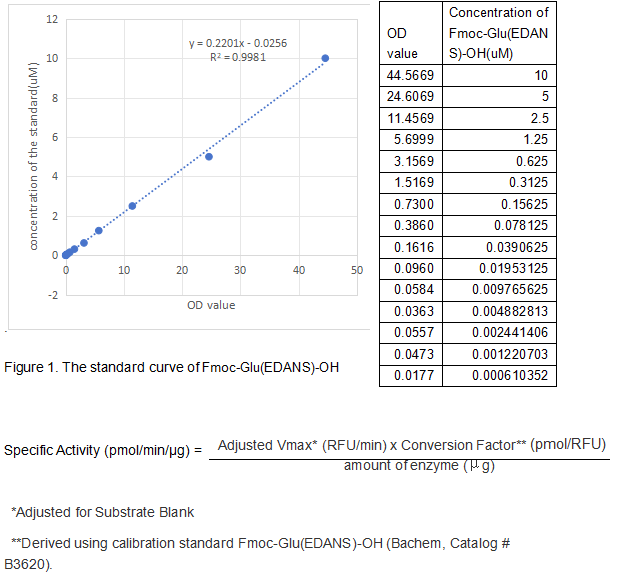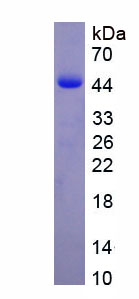Active Renin (REN) 

angiotensinogenase
- UOM
- FOB US$ 343.00 US$ 858.00 US$ 1,716.00 US$ 5,148.00 US$ 12,870.00
- Quantity
Overview
Properties
- Product No.APA889Hu61
- Organism SpeciesHomo sapiens (Human) Same name, Different species.
- ApplicationsCell culture; Activity Assays.
Research use only - DownloadInstruction Manual
- CategoryEndocrinologyCardiovascular biologyKidney biomarkerHormone metabolism
- Buffer FormulationPBS, pH7.4, containing 5% Trehalose.
- Traits Freeze-dried powder, Purity > 97%
- Isoelectric Point6.1
Sign into your account
Share a new citation as an author
Upload your experimental result
Review

Contact us
Please fill in the blank.
Activity test

Renin is an enzyme that plays a crucial role in the regulation of blood pressure and electrolyte balance by activating the renin-angiotensin-aldosterone system (RAAS). It is secreted by the kidneys in response to low blood pressure or low sodium levels.The activity of recombinant human REN is measured by its ability to cleave a fluorogenic peptide substrate Arg-Glu(EDANS)-Ile-His-Pro-Phe-His-Pro-Phe-His-Leu-Val-Ile-His-Thr-Lys(dabcyl)-Arg
in the assay buffer 50 mM Sodium Acetate, 150 mM NaCl, 2 mM EDTA, pH 5.0 .Recombinant human REN was diluted to 200ug/ml in the activation buffer 5 mM Tris, 15 mM NaCl, 1 mM CaCl2, 0.005% Brij-35, pH 7.5, then activated by Trypsin in a final concentration of 4ug/ml incubated at 37 °C for 1 hours. Stop activation with PMSF at 1 mM and incubate at room temperature for 30 min.The activated rhREN is diluted toto different concentrations in assay buffer. Loading into a black well plate 50 µL rhREN and start the reaction by adding 50 µL of 20 µM substrate, with a substrate blank containing 50 µL assay buffer, 50 µL substrate, and no rhREN.Then read at excitiation and emission wavelengths of350 nm and 490 nm, respectively, in kinetic mode for 5 minutes. The specific activity of rhREN is >13 pmol/min/µg
Usage
Reconstitute in 10mM PBS (pH7.4) to a concentration of 0.1-1.0 mg/mL. Do not vortex.
Storage
Avoid repeated freeze/thaw cycles. Store at 2-8°C for one month. Aliquot and store at -80°C for 12 months.
Stability
The thermal stability is described by the loss rate. The loss rate was determined by accelerated thermal degradation test, that is, incubate the protein at 37°C for 48h, and no obvious degradation and precipitation were observed. The loss rate is less than 5% within the expiration date under appropriate storage condition.
Increment services
-
 BCA Protein Quantification Kit
BCA Protein Quantification Kit
-
 Molecular Mass Marker for Protein
Molecular Mass Marker for Protein
-
 Monoclonal Antibody Customized Service
Monoclonal Antibody Customized Service
-
 Polyclonal Antibody Customized Service
Polyclonal Antibody Customized Service
-
 Protein Activity Test Experiment Service
Protein Activity Test Experiment Service
-
 Electrophoretic Mobility Shift Assay (EMSA) Experiment Service
Electrophoretic Mobility Shift Assay (EMSA) Experiment Service
-
 Buffer
Buffer
-
 Lentivirus Packaging Experiment Service
Lentivirus Packaging Experiment Service
-
 Adenovirus Packaging Experiment Service
Adenovirus Packaging Experiment Service
-
 Real Time PCR Experimental Service
Real Time PCR Experimental Service
-
 Spike RBD Protein (S-RBD)
Spike RBD Protein (S-RBD)
-
 Protein G
Protein G
-
 Protein A
Protein A
Citations
- Prenatal overexposure to glucocorticoids programs renal 11β-hydroxysteroid dehydrogenase type 2 expression and salt-sensitive hypertension in the ratPubMed: 21045727
- Recombinant human erythropoietin in humans down-regulates proximal renal tubular reabsorption and causes a fall in glomerular filtration rate Physoc: 194241
- Erythropoietin down‐regulates proximal renal tubular reabsorption and causes a fall in glomerular filtration rate in humansPubMed: 20724370
- Anti-Angiotensin and Hypoglycemic Treatments Suppress Liver Metastasis of Colon Cancer CellsKarger: 000330169
- The Angiotensin Receptor Blocker, Azilsartan Medoxomil (TAK-491), Suppresses Vascular Wall Expression of Plasminogen Activator Inhibitor Type-I Protein Potentially Facilitating the Stabilization of Atherosclerotic PlaquesLWW: 08000
- Multiple and large simple renal cysts are associated with prehypertension and hypertension.Pubmed: 23389415
- Estimation of the parameters of the renin-angiotensin-aldosterone system, water-electrolyte metabolism, and endothelial function in newborns of women with chronic hypertensionSpringer:Source
- Organ-Specific Activation of the Gastric Branch of the Efferent Vagus Nerve by Ghrelin in Urethane-Anesthetized RatsPubmed:24366191
- VSL#3 probiotic treatment decreases bacterial translocation in rats with carbon tetrachloride-induced cirrhosisPubmed:24750552
- Immunological and hemostasiological disorders in women with ovarian hyperstimulation syndromePubmed:25200828
- Age-Associated Changes in the Vascular Renin-Angiotensin System in MicePubmed:27200147
- Ablation of Potassium-Chloride Cotransporter Type 3 (Kcc3) in Mouse Causes Multiple Cardiovascular Defects and Isosmotic PolyuriaPubmed:27166674
- Reduced Expression of the Extracellular Calcium-Sensing Receptor (CaSR) Is Associated withActivation of the Renin-Angiotensin System (RAS) to Promote Vascular Remodeling in the Pathogenesis of Essential Hypertension.pubmed:27391973
- Efficacy and Safety of Renal Sympathetic Denervation on Dogs with Pressure Overload-Induced Heart Failure.pubmed:27555054
- Sacubitril/valsartan (LCZ696) Significantly Reduces Aldosterone and Increases cGMP Circulating Levels in a Canine Model of RAAS ActivationDoi: 10.1101/435560
- Gut Dysbiosis Contribute to High Fructose Induced Salt Sensitive Hypertension In Sprague-Dawley Rats
- The vascular endothelial growth factor trap aflibercept induces vascular dysfunction and hypertension via attenuation of eNOS/NO signaling in mice33303990
- Association of Ang-(1¨C7) and des-Arg 9 BK as new biomarkers of obesity and cardiometabolic risk factors in adolescents33568792
- Phosphorylation of β1-integrin in juxtaglomerular cells helps control blood pressure during the progression of diabetic nephropathy
- Bedeutung des intrarenalen Renin-Angiotensin-Systems f¨¹r die Entwicklung der chronischen Nierenkrankheit







